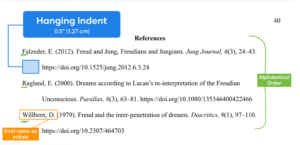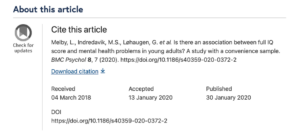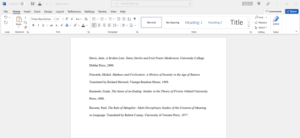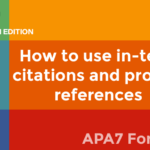How to use in-text citations and proper references
When writing academic papers in APA format, one of the most important elements of a well-written paper is citing sources and references properly. Failure to correctly identify where your information is coming from is considered plagiarism, resulting in a grade of 0 for a university essay or annulment of your research findings in a graduate dissertation.
In-text citations are the simplest way of crediting your information, and they are as follows:
- The first kind of in-text citations are the ones you use when paraphrasing what your source said. These are known as parenthetical The method used is author-date, where you first write the author’s name and follow it with a comma and the year the work was published.
- The second kind of in-text citation is narrative citation and is used when incorporating the author’s name earlier in the sentence. This way, the citation only includes the year of publication (and page/line number, if available), and the author’s name is not repeated. This should result in a seamless citation within the sentence.
Parenthetical Citation Example:
Stein (2018) studied whether the early onset of Alzheimer disease affected individuals younger than 30. His findings revealed that individuals as young as 20 were affected by the disease (p.42). Another study found similar data, showing that individuals as young as 18 displayed symptoms of the disease (Tang & Pierce, 2014, p. 231). Even though both studies involved individuals in different hemispheres, the results were similar.
Narrative Citation Example:
In Edgar Allan Poe’s famous poem, The Raven, the gloomy aura of a “midnight dreary” (1845, line 1) sets the scene from the very first stanza, so that the reader understands the mindset of the poem’s speaker and feels the unsettling progression of the story.
Tip: Microsoft Word has a built-in feature for adding citations. Go to the top of your document, click on the fifth tab after Home titled “References”, and choose APA style. From there you can insert in-text citations. Although this can be a good start, make sure you always double-check if all the information needed is included, and if you are using the correct information and citation type.

Note: The availability of this feature will depend on which MS Word software and version you are using.
References
The purpose of a reference page is for the reader of your work to be able to find from where exactly the information was obtained and refer to your sources as needed. Every citation you include in any work must have a reference to match, and vice versa. In APA 7 format, references are presented as the last page of any work in a detailed list that follows a specific set of rules:
- Reference list items must always be in alphabetical order.
- All items must be written with a hanging indent.
- Write authors’ first and middle names as initials.

The rules applied to your reference list depend on what kind of source you used (book, journal, newspaper) and whether this source was in printed or online format.
Journals
Journals are one of the most common sources in academic publications, in part because of their high reliability (all reputable research journals should be peer-reviewed). All online publications have a DOI, a set of letters and symbols that identify an article/document specifically. DOI stands for Digital Object Identifier—basically your source’s ID. It’s important to take note of the DOI as it is included in your reference and can be used to find any article on the web.
Imagine you wrote the following sentence in your paper:
Interestingly, other studies have found that people that place on the borderline/lower end of the IQ curve (IQ < 70) tend to be at an increased risk of developing psychiatric disorders (Melby et al., 2020).
Now, most articles already have an option along the lines of “Cite this article”, and clicking on this will give you all the information needed. For the previous example, it shows up like this:

Your information goes in the following order:
- Author or authors. Capitalize the surname followed by their first name as an initial with a period at the end.
- Publication year. Write the publication date of your article inside parentheses, with a period at the end.
- Article title, capitalize the first word only. Write it exactly as it appears in your source, adding a period at the end of the title.
- Journal title (where the article was published) in italics.
- Journal volume and issue. Follow the journal title with a comma, then the number of the volume (still in italics), and finally the issue number inside parentheses (without italics).
- Page range. If available, add the page numbers where your information was taken from after the journal issue number (after a comma). Finish with a period. If no page range is available, simply put a period after the parentheses enclosing the issue number.
- DOI or URL. Finish your reference with the copied DOI link taken directly from the journal article used.
- Don’t forget hanging indents! The following animated gif shows you how to apply them in Microsoft Word.

Following this list, the previous example would result in this reference:
Melby, L., Indredavik, M. S., Løhaugen, G., Brubakk, A. M., Skranes, J., & Vik, T. (2020). Is there an association between full IQ score and mental health problems in young adults? A study with a convenience sample. BMC Psychology, 8(1). https://doi.org/10.1186/s40359-020-0372-2
** If you’re still having trouble creating your reference list or using in-text citations, the Purdue Online Writing Lab has a great resource you can use as guidance:
The American Psychological Association (creators and moderators of APA style formatting) also has an official website that summarizes many of their rules and guidelines. You can access it here:
- In-text citations: https://apastyle.apa.org/style-grammar-guidelines/citations
- References: https://apastyle.apa.org/style-grammar-guidelines/references













